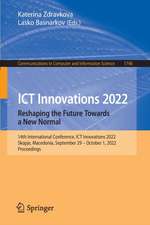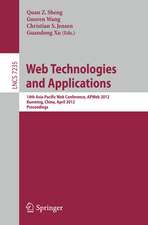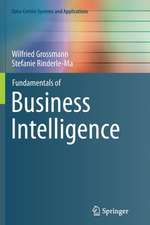Data Integration in the Life Sciences: 4th International Workshop, DILS 2007, Philadelphia, PA, USA, June 27-29, 2007, Proceedings: Lecture Notes in Computer Science, cartea 4544
Editat de Sarah Cohen-Boulakia, Val Tannenen Limba Engleză Paperback – 12 iun 2007
Din seria Lecture Notes in Computer Science
- 20%
 Preț: 1061.55 lei
Preț: 1061.55 lei - 20%
 Preț: 307.71 lei
Preț: 307.71 lei - 20%
 Preț: 438.69 lei
Preț: 438.69 lei - 20%
 Preț: 645.28 lei
Preț: 645.28 lei -
 Preț: 410.88 lei
Preț: 410.88 lei - 15%
 Preț: 580.46 lei
Preț: 580.46 lei - 17%
 Preț: 427.22 lei
Preț: 427.22 lei - 20%
 Preț: 596.46 lei
Preț: 596.46 lei -
 Preț: 381.21 lei
Preț: 381.21 lei - 20%
 Preț: 353.50 lei
Preț: 353.50 lei - 20%
 Preț: 1414.79 lei
Preț: 1414.79 lei - 20%
 Preț: 309.90 lei
Preț: 309.90 lei - 20%
 Preț: 583.40 lei
Preț: 583.40 lei - 20%
 Preț: 1075.26 lei
Preț: 1075.26 lei - 20%
 Preț: 310.26 lei
Preț: 310.26 lei - 20%
 Preț: 655.02 lei
Preț: 655.02 lei - 20%
 Preț: 580.93 lei
Preț: 580.93 lei - 20%
 Preț: 340.32 lei
Preț: 340.32 lei - 15%
 Preț: 438.59 lei
Preț: 438.59 lei - 20%
 Preț: 591.51 lei
Preț: 591.51 lei - 20%
 Preț: 649.49 lei
Preț: 649.49 lei - 20%
 Preț: 337.00 lei
Preț: 337.00 lei -
 Preț: 449.57 lei
Preț: 449.57 lei - 20%
 Preț: 607.39 lei
Preț: 607.39 lei - 20%
 Preț: 1024.44 lei
Preț: 1024.44 lei - 20%
 Preț: 579.30 lei
Preț: 579.30 lei - 20%
 Preț: 763.23 lei
Preț: 763.23 lei - 20%
 Preț: 453.32 lei
Preț: 453.32 lei - 20%
 Preț: 575.48 lei
Preț: 575.48 lei - 20%
 Preț: 585.88 lei
Preț: 585.88 lei - 20%
 Preț: 825.93 lei
Preț: 825.93 lei - 20%
 Preț: 763.23 lei
Preț: 763.23 lei - 17%
 Preț: 360.19 lei
Preț: 360.19 lei - 20%
 Preț: 1183.14 lei
Preț: 1183.14 lei - 20%
 Preț: 340.32 lei
Preț: 340.32 lei - 20%
 Preț: 504.57 lei
Preț: 504.57 lei - 20%
 Preț: 369.12 lei
Preț: 369.12 lei - 20%
 Preț: 583.40 lei
Preț: 583.40 lei - 20%
 Preț: 343.62 lei
Preț: 343.62 lei - 20%
 Preț: 350.21 lei
Preț: 350.21 lei - 20%
 Preț: 764.89 lei
Preț: 764.89 lei - 20%
 Preț: 583.40 lei
Preț: 583.40 lei -
 Preț: 389.48 lei
Preț: 389.48 lei - 20%
 Preț: 341.95 lei
Preț: 341.95 lei - 20%
 Preț: 238.01 lei
Preț: 238.01 lei - 20%
 Preț: 538.29 lei
Preț: 538.29 lei
Preț: 332.57 lei
Preț vechi: 415.71 lei
-20% Nou
Puncte Express: 499
Preț estimativ în valută:
63.64€ • 66.04$ • 53.20£
63.64€ • 66.04$ • 53.20£
Carte tipărită la comandă
Livrare economică 15-29 martie
Preluare comenzi: 021 569.72.76
Specificații
ISBN-13: 9783540732549
ISBN-10: 3540732543
Pagini: 296
Ilustrații: XI, 284 p. With online files/update.
Dimensiuni: 155 x 235 x 16 mm
Greutate: 0.42 kg
Ediția:2007
Editura: Springer Berlin, Heidelberg
Colecția Springer
Seriile Lecture Notes in Computer Science, Lecture Notes in Bioinformatics
Locul publicării:Berlin, Heidelberg, Germany
ISBN-10: 3540732543
Pagini: 296
Ilustrații: XI, 284 p. With online files/update.
Dimensiuni: 155 x 235 x 16 mm
Greutate: 0.42 kg
Ediția:2007
Editura: Springer Berlin, Heidelberg
Colecția Springer
Seriile Lecture Notes in Computer Science, Lecture Notes in Bioinformatics
Locul publicării:Berlin, Heidelberg, Germany
Public țintă
ResearchCuprins
Keynote Presentations.- Enabling the Molecular Medicine Revolution Through Network-Centric Biomedicine.- Phyl-O’Data (POD) from Tree of Life: Integration Challenges from Yellow Slimy Things to Black Crunchy Stuff.- New Architectures and Experience on Using Systems.- Automatically Constructing a Directory of Molecular Biology Databases.- The Allen Brain Atlas: Delivering Neuroscience to the Web on a Genome Wide Scale.- Toward an Integrated RNA Motif Database.- B-Fabric: A Data and Application Integration Framework for Life Sciences Research.- SWAMI: Integrating Biological Databases and Analysis Tools Within User Friendly Environment.- Grid and UTOPIA: An Integrated Approach to Enacting and Visualising in Silico Experiments in the Life Sciences.- Managing and Designing Scientific Workflows.- A High-Throughput Bioinformatics Platform for Mass Spectrometry-Based Proteomics.- Bioinformatics Service Reconciliation by Heterogeneous Schema Transformation.- A Formal Model of Dataflow Repositories.- Project Histories: Managing Data Provenance Across Collection-Oriented Scientific Workflow Runs.- Mapping and Matching Techniques.- Fast Approximate Duplicate Detection for 2D-NMR Spectra.- Ontology – Supported Machine Learning and Decision Support in Biomedicine.- Instance-Based Matching of Large Life Science Ontologies.- Modeling of Life Science Data.- Data Integration and Pattern-Finding in Biological Sequence with TESS’s Annotation Grammar and Extraction Language (AnGEL).- Inferring Gene Regulatory Networks from Multiple Data Sources Via a Dynamic Bayesian Network with Structural EM.- Accelerating Disease Gene Identification Through Integrated SNP Data Analysis.- Annotation in Data Integration.- What’s New? What’s Certain? – Scoring Search Results in the Presenceof Overlapping Data Sources.- Using Annotations from Controlled Vocabularies to Find Meaningful Associations.- CONANN: An Online Biomedical Concept Annotator.




























